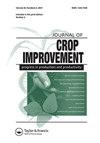伊朗寒冷地区大麦苗种的GGE双图分析
IF 1.5
Q3 AGRONOMY
引用次数: 11
摘要
在多环境试验(METs)中,基因型与环境(GE)相互作用的研究对于鉴定高产、稳定或特异性适应的基因型具有重要意义。本研究的主要目的是利用在MET中评估的一些有前途的大麦(Hordeum vulgare L.)品系,通过GGE双图分析来评估GE相互作用,以确定在伊朗寒冷地区具有高产和产量稳定的基因型。在位于寒区不同地区的6个研究站,连续两个种植季(2016-17和2017-18)对18个有潜力的大麦品系和2个对照品种进行了评价。结果表明,G1、G2、G4和G8属于高产且跨环境性能稳定的品种。此外,GGE双图分析表明,这些基因型与G19和G20基因型一起是最理想的基因型。其中,G8和G20表现出最高的产量表现。基因型G15 (Germunk3)特别适合一些地区,如哈马丹省。另一方面,基因型G8 (Makouee/Jolgeh)对不同环境具有普遍的适应性,可以作为大麦新基因型推荐用于伊朗大多数寒冷地区的栽培。本文章由计算机程序翻译,如有差异,请以英文原文为准。
GGE biplot analysis of promising barley lines in the cold regions of Iran
ABSTRACT In multi-environment trials (METs), the study of genotype × environment (GE) interaction is important for identifying high-yielding and stable or specifically adapted genotypes. The main objective of this study was to evaluate the GE interaction via GGE biplot analysis using some promising barley (Hordeum vulgare L.) lines evaluated in an MET to identify genotypes possessing high yield and yield stability in the cold regions of Iran. Eighteen promising barley lines, along with two check cultivars, were evaluated during two consecutive cropping seasons (2016–17 and 2017–18) at six research stations located in different regions of the cold zone. The results demonstrated that G1, G2, G4, and G8 were among those with high-yield and stable performance across environments. Moreover, GGE biplot analysis identified these genotypes along with G19 and G20 as the most ideal genotypes. Of these, G8 and G20 showed the highest yield performance. Genotype G15 (Germunk3) was specifically adapted for some regions such as Hamadan province. On the other hand, genotype G8 (Makouee/Jolgeh) had general adaptability across different environments and can be recommended as a new barley genotype for cultivation in most cold regions of Iran.
求助全文
通过发布文献求助,成功后即可免费获取论文全文。
去求助
来源期刊

Journal of Crop Improvement
Multiple-
CiteScore
3.30
自引率
7.70%
发文量
42
期刊介绍:
Journal of Crop Science and Biotechnology (JCSB) is a peer-reviewed international journal published four times a year. JCSB publishes novel and advanced original research articles on topics related to the production science of field crops and resource plants, including cropping systems, sustainable agriculture, environmental change, post-harvest management, biodiversity, crop improvement, and recent advances in physiology and molecular biology. Also covered are related subjects in a wide range of sciences such as the ecological and physiological aspects of crop production and genetic, breeding, and biotechnological approaches for crop improvement.
 求助内容:
求助内容: 应助结果提醒方式:
应助结果提醒方式:


